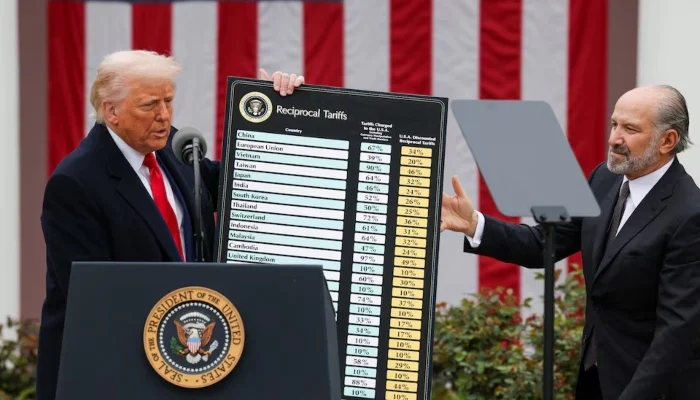US President Donald Trump asserted in an interview published on Friday that tariff negotiations were underway with China, but Beijing refuted these claims, adding to the ongoing confusion surrounding progress in de-escalating the trade war that threatens global economic growth.
Trump told TIME magazine that talks were ongoing and that Chinese President Xi Jinping had called him, a statement he reiterated to reporters as he departed the White House for Rome on Friday morning to attend Pope Francis’s funeral.
China, through its foreign ministry, issued a swift denial via a statement posted by the Chinese Embassy in the US, stating, “China and the US are NOT having any consultation or negotiation on #tariffs. The US should stop creating confusion.”
Later on Friday, while speaking to reporters aboard Air Force One, Trump indicated that opening up Chinese markets to US products would be a victory, and tariffs could be a means to achieve that.
“Free up China. You know, let us go in and work China,” he said. “That would be great. That would be a big win, but I’m not even sure I’m going to ask for it because they don’t want it open.”
On Saturday, Chinese Foreign Minister Wang Yi emphasized that Beijing adheres to international rules regarding US-imposed tariffs and would seek solidarity with other nations.
According to a statement from China’s foreign ministry, Wang, speaking at a regional meeting in Kazakhstan, said, “Certain countries adhere to their own priorities, engage in bullying pressure and coercive transactions, and provoke trade wars for no reason, exposing their extreme egoism.”
This exchange of conflicting statements adds to the significant uncertainty surrounding Trump’s unpredictable tariff policy, not only concerning China but also regarding the numerous countries attempting to negotiate deals to mitigate the impact of the substantial import taxes imposed since his return to the White House in January.
His negotiation team conducted a rapid series of trade talks with foreign officials who had gathered in Washington for the spring meetings of the International Monetary Fund and World Bank Group.
While Trump administration officials, including Treasury Secretary Scott Bessent, indicated swift progress, many of their counterparts were more cautious. Finance chiefs at the IMF returned home with renewed urgency to address the risks posed by the tariffs.
Irish Finance Minister Paschal Donohoe told Reuters, “I’m walking away from these meetings with a clear sense of everything that is at stake and the risks that are there for jobs, for growth, for living standards all over the world.”
“The meetings here… reminded me of why we need to leave no stone unturned in the next few weeks and months to see how we can reduce that uncertainty.”
De-escalation Efforts
While clarity on potential deals to avoid further tariff increases in July remained elusive, there were some signs of de-escalation.
China exempted certain US imports from its tariffs, and business groups reported that Beijing had allowed some US-made pharmaceuticals to enter the country without paying the 125% duties imposed earlier in the month in response to Trump’s 145% tariffs on Chinese imports.
Additionally, a list of 131 product categories reportedly under consideration for exemptions circulated among businesses and trade groups. Reuters could not verify the list, which included vaccines, chemicals, and jet engines, and China did not publicly comment on the matter.
The Trump administration also signaled a desire to de-escalate tensions with China, with Bessent stating that both sides considered the current situation unsustainable.
Trump told reporters at the White House that a deal with Japan was imminent, which analysts viewed as a “test case” for other bilateral trade agreements, although negotiations could be challenging. Some expected Prime Minister Shigeru Ishiba and Trump to announce an agreement at the G7 summit in Canada in June.
Trump also told TIME that he had secured “200 deals” that would be finalized within three to four weeks, although he did not provide details. He indicated that he would consider it a “total victory” if tariffs remained between 20% and 50% in a year.
The president argued that his trade barriers would revive US manufacturing industries that had been weakened by global competition.
However, economists generally warned that these tariffs would lead to higher prices for US consumers and increase the risk of recession.
US stocks experienced a weekly gain, but they were down approximately 10% since Trump’s return to office in January, lagging behind indexes in other countries, and the dollar had declined at an unprecedented rate.
European and Asian stocks were poised for a second consecutive week of gains on Friday, and the dollar was on track for its first weekly rise in over a month, as investors were encouraged by signs of potential de-escalation in the US-China trade war.
Wall Street’s main indexes rose slightly as investors sought clarity on the US-China trade situation.
In addition to country-specific tariffs, Trump imposed a 10% blanket tariff on all other US imports and higher duties on steel, aluminum, and automobiles.
He also considered additional industry-specific levies on pharmaceuticals and semiconductors, which could raise drug prices in the US by up to 12.9%, according to industry estimates.
Trump’s tariffs dominated discussions at the IMF meetings, where finance ministers sought meetings with the US treasury secretary.
Bessent described initial talks with South Korea as “very successful” on Thursday, and Seoul called them a “good start.” Further discussions were scheduled for the following week.
Switzerland expressed satisfaction with its initial meeting with Bessent. The US trade office stated that it was “constantly engaged” with Japan and other countries, but Trump would ultimately decide whether to proceed with agreements.
There was limited evidence of tangible progress with other countries, despite warnings from IMF head Kristalina Georgieva about the potential for severe global growth slowdown.



